Arunachal Pradesh Culture
With 26 major tribes each having their own set of traditions and customs, Arunachal is a land of wild diversity with cultural variations delineating each tribal sect from the other.
Every tribe follows their code of conduct and social norms as they live in cohesive unit within the geographical boundaries.
Three broad cultural groups of Arunachal Pradesh
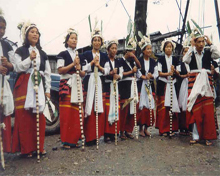 The Arunachali people are divided into three cultural groups on the basis of their socio-religious practices. The Monpas and Sherdukpens of Tawang and West Kameng districts follow the lamaistic tradition of Mahayana Buddhism.
The Arunachali people are divided into three cultural groups on the basis of their socio-religious practices. The Monpas and Sherdukpens of Tawang and West Kameng districts follow the lamaistic tradition of Mahayana Buddhism.
Known for their religious zeal, the villages of these communities have richly decorated Buddhist temples called Gompas. Basically farmers adopting terrace cultivation, the Monpas and Sherdukpens lead a pastoral life breeding herds of yaks and mountain sheep.
There are other tribes with similar lifestyle - Membas and Khambas who live in the high mountains on the northern borders.
While Khamptis and Singphos living in the eastern part of the state are Buddhists of Hinayana sect.
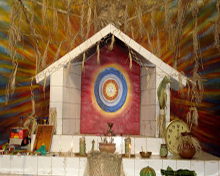 They are said to have migrated from Thailand and Burma long ago and still use ancient scripts derived from their original homeland. The second group of tribals - Adis, Akas, Apatanis, Bangnis, Nishis, Mishmis, Mijis and Thongsas, among others - worship Sun and Moon Gods namely, Donyi-Polo and Abo-Tani, the original ancestors for most of these tribes.
They are said to have migrated from Thailand and Burma long ago and still use ancient scripts derived from their original homeland. The second group of tribals - Adis, Akas, Apatanis, Bangnis, Nishis, Mishmis, Mijis and Thongsas, among others - worship Sun and Moon Gods namely, Donyi-Polo and Abo-Tani, the original ancestors for most of these tribes.
Their religious rituals coincide with the various phases of agricultural cycles.
Nature deities are worshipped by this group and animal sacrifices are common.They traditionally practice jhumming or shifting cultivation.
Adis and Apatanis practice wet rice cultivation and have built a good economy over farming activities. Apatanis are reputed for their paddy-cum-pisciculture as they have specialised in harvesting two crops of fish along with each crop of paddy for over centuries.
The third cultural group comprises Noctes and Wanchos adjoining Nagaland in the Tirap district. They are tough and strong people known for their structured village society in which hereditary village chief lays down the code of conduct and social norms.
The Noctes practise the elementary form of Vaishnavism.
Tribal beliefs
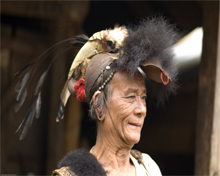 The sun and the moon are the presiding deities of the major tribes who follow the Donyi-Polo religion (the name stands for sun and moon).
The sun and the moon are the presiding deities of the major tribes who follow the Donyi-Polo religion (the name stands for sun and moon).
The West Kameng and Tawang districts are mainly inhabited by the Tibetan influenced Monpa and Sherdukpen tribes.
In Lohit district it is the Khampti and the Singpho tribe. All these four major tribes are followers of two different sects of Buddhism (Mahayana and Hinayana).
The other tribes are basically followers of ancient beliefs with animal worship being quite prominent amongst them.
Festivals Celebrates in Arunachal Pradesh
Colourful festivals with group dance and song mark the cultural lifestyle of Arunachal tribes.
As most of them till the land for livelihood, the tribal communities thank Gods for showering them with bounty harvest during the celebrations.
Besides, the people showcase their artistic skills during such large gatherings and one has to visit Ziro district which hosts a number of festivals to understand the pomp and pageantry that accompany these events.
Languages speaks in Arunachal Pradesh
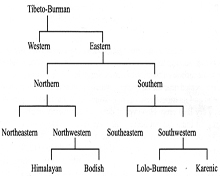 In terms of linguistic diversity, the people speak over 50 dialects, most of which have roots from the Tibeto-Burman language structure.
In terms of linguistic diversity, the people speak over 50 dialects, most of which have roots from the Tibeto-Burman language structure.
Some of the prominent languages like Nyishi, Bangni, Apatani, Hills Miri, Bokar, Galo, Tagin, Lower Adi, Uper Adi, Mising, and Milang are widely spoken in Arunachal and they fall under the Tani dialect, a type of Tibeto-Burman language.
In the eastern part of the state, it is the Mishmi language which is widely spoken. Digaru, Idu and Miju are endangered dialects under the Mishmi language.
In the west and the north, people speak the Bodic language which is sub-divided into two dialects, namely - Dakpa and Tshangla.
Social structure of Arunachal Pradesh
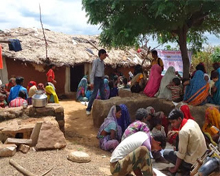 The tribals have highly ordered and organised system of functioning in their villages.
The tribals have highly ordered and organised system of functioning in their villages.
All matters relating to the community as a whole are decided at the village level.
The socio-administrative structure of the society that had evolved over centuries recognises democratic partition right down to the level of villages.
The traditional panchayat of an Adi village is locally known as 'Kebang' which is judicio-administrative body, consisting of mature and influential elders.
Kebang looks after the administration of justice in the society by setting all matters of dispute.
Such autonomous bodies exist among other tribes and they are variously called as Jong among the Sherdukpens, Mel among the Akas, Buliang among the Apaptanis and so on.
Group dance is common in Arunachal Pradesh
Dances are quite popular among tribes as they give expression to their joy through such fine arts.
For recreation, light entertainment and during festivals, tribes perform group dance along with chorus singing which is an important ritual to them.
They vary from highly codified religious dramas of the Buddhists to the martial steps and colourful performances of the Noctes and Wanchos.
Usually both men and women take part in the group dance of Arunachal people.
But there are some dances which are exclusively for the male - Igu dance of the Mishmi priests; war dances of the Adis, Noctes and Wanchos; and the ritualistic dance of the Buddhist tribes.
Females are not allowed to dance in these dances.
Some of the popular folk dances are Aji Lamu (Monpa), Roppi (Nishing), Hiirii Khaniing (Apatani), Popir (Adi), Pasi Kongki (Adi), Chalo (Nocte), Ponung (Adi), Rekham Pada(Nishing), Lion and Peacock dance (Monpa), among others.
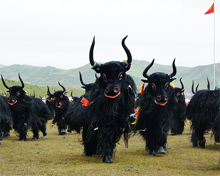 Most of the dances are accompanied by songs sung in chorus.
Most of the dances are accompanied by songs sung in chorus.
The Monpas used to perform Monastic dances for three days during Torgya festivals. They are skilled in performing a number of dances on special occasions.
Some of them are Aji Lhamu dance, yak dance and lion and peacock dances among others.
For the Adis, dance had evolved into an aesthetic art form for entertainment and recreation. The 'Phoning' dance of Adis is performed by teams of young girls in rhythmic unison. Similar group dance in colourful costumes are performed by Nishis and Tagins of Upper and Lower Subansiri districts.